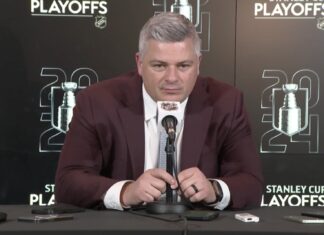In today’s links, Travis Dermott discusses the heightened competition level on the blue line in training camp, his preference for playing the right side, and the addition of veteran Joe Thornton to the organization. Darren Dreger and Michael Russo also provide updates on the NHL’s Return to Play challenges for 2020-21.
Leafs Links
Dreger: Zach Bogosian took less to come to Toronto (TSN1050)
Darren Dreger joined Leafs Lunch to discuss the Leafs‘ blue line depth options as well as the Return to Play dynamics for the 2020-21 season.
Zach Bogosian, coming off of winning a Stanley Cup with the Tampa Bay Lightning — granted, towards the end, he was in and out of the lineup — I know left money on the table, a fair chunk from other teams with interest. He chose to play in Toronto. If he is choosing to play in Toronto, I’ve got to believe the conversations he had with Kyle Dubas and Sheldon Keefe were substantial enough that he is going to be in the lineup. He is probably not going to be the #7 guy.
[Dermott] showed a fair bit of maturity in his media availability after the signing, just saying, “I just wanted to get it done. I am not worried about the money or the term. I just want to play hockey.” That’s the attitude you want. You want guys hungry. Bogosian is probably not going to be the 7th or 8th defenseman for the Leafs because he now knows what it takes to win… They’ve got some balance on defense for the first time in a long time. Rasmus Sandin has to be wanting and ready to take the next step. You’ve got young guys like that looking to make their way, Lehtonen included, balanced with the experience and leadership back there. I think Toronto’s blue line is going to be really solid.
Dreger on Return to Play, 2020-21 edition:
I have talked to owners that say not playing is a possibility. Obviously, that is not their first priority. But it comes down to an economic decision, too. What is the scenario that results in the fewest losses — 100s of millions of dollars league-wide, I’m sure. The possibility of not playing isn’t high on the list of anyone, but we have to see what happens in the world with COVID-19.
The NHL and NHLPA haven’t even started their negotiation here. What they’re waiting for, in fairness to the NHL, is that the NHL is doing a real deep dive on cost analysis for all 31 teams — how much revenue they bring, how much of their revenue is attached to tickets. There are teams on the lower end that rely on upwards of $90 million in gate receipts. If that isn’t there, that is a pretty big hole in the revenue stream.
… In terms of losses, not playing might save the owners money, but here is the other thing that needs to be concerned: When owners might have said to him, “I can’t afford to lose that much money, I rather not play,” he probably acknowledges that but says, “If basketball is going and football is going and everything else is going, hockey is going to become irrelevant in parts of North America, and that is too big of a gamble.”
I don’t know when they are going to start. Some are projecting late January or early February — very speculatively speaking — but the notion of not playing probably doesn’t make a lot of sense.
I believe the commissioner’s office is continuing to gather that league-wide economic intelligence, and then he can take that into the discussions with the NHLPA committee, which includes 10 NHL players, and they can negotiate on that. It seems behind schedule — originally, they wanted to get going a week or 10 days after the Stanley Cup. There are lots of discussions happening between Bettman, Daly, Don Fehr, and his lieutenants at the NHLPA, but the larger group hasn’t met yet. If they don’t do that this week, I think concern will grow.
Dermott: I love playing the right side (MapleLeafs.com)
Travis Dermott spoke with the media over the weekend after signing a one-year contract with the Leafs worth $874k, discussing the amount of competition on the depth chart, the possibility of playing the right, and Joe Thornton joining the team.
Dermott on the heightened competition level at camp:
It’s exciting. I always like a good competition. We’ll see how camp goes, whenever that gets started. We are going to be that much better with that much more competition, right? We are going to get guys pushing each other and really force guys to be their best version of themselves and to be really prepared come camp time.
… Keefer knows how I play when I am at my best. I know how I play when I am at my best. That is what they expect from me. Anything less, there are guys biting at my heels to get in and steal my job. My job is to come in and play my game and do exactly what they want me to do. It is just coming in, getting it done, and being consistent.
It’s what you kind of build for yourself — a little portfolio of the things you do well. Keefer and I have grown through the years and I have understood how my portfolio has grown. It is just bringing that every night and trying to be consistent with it.
Dermott on playing the right side:
I love the right side. I played the right side in junior. It is nice. There are actually a lot of parts to the game I like better or find easier on the right side. I am not scared of that task at all. It is pretty exciting.
In the offensive zone, you’re more available for a quick shot from your D partner. Some breakout stuff is easier because your body is more open to the ice. Some little things — early takes, if I am on the right side and a forward is trying to go wide on me, I have my forehand dragging behind me instead of having to put one hand on the stick. It’s little things like that. There are a lot of times around the ice where it is completely different from the left than right, but there are some things that definitely feel nice.
As far as training goes, as much as I am on the ice, you try to get reps on the right side and some on the left. You try to keep all options open and you don’t lock yourself in, so that whatever situation arises, Keefer can throw me out.
–
Dermott on the signing of Joe Thornton:
It’s going to be really cool having him on the bench beside me. He is definitely a guy I’d never thought I would be playing with. He’s a guy I grew up watching play a lot. It is very exciting to have him there.
Russo: Going to have to be a settlement between owners, players (TSN1050)
The Athletic’s Michael Russo joined Leafs Lunch to discuss the challenges surrounding Return to Play for the 2020-21 season and what the logistics of putting on the season might be like.
Russo on owners’ concerns about the financial hit of playing vs. not playing:
The players extended the collective bargaining agreement under the belief that they knew what next season’s salary would be — a 10% deferral, then 20% escrow on the 90%, which meant they would be playing for 72% of their salaries. Those were the terms of the Memorandum of Understanding of the CBA. Now you are starting to hear owners scoffing that they never thought, come January, we would still be in a position where not only would they be potentially paying this type of salary, but they wouldn’t be getting any revenue back other than TV money and merchandise and maybe advances on the expansion fee. You are starting to hear owners say, “Well, why are we doing this?” They would lose a lot less money not playing than playing.
The league feels that the damage that would be done to the brand by suddenly going dark until September would be irreparable. That is where they are at. When I pointed out to Bill Daly that the MOA clearly spells out what the players are supposed to make next season, his replay was, “You’re definitely reading it right, but with anything, it has to be negotiated.” He kind of subtly said they all want to play next season, which made me think this is going to be their debate with the players: This is something our owners are not willing to stomach. Now, suddenly, that is one of the things that is going to have to come down to some sort of settlement between them and the players.
[The players] understandably won’t like that. They feel like that’s why they extended the CBA… This is why the Return to Play had to be with the CBA. Don Fehr said to the players that the Return to Play is tied into the CBA. Now, all of a sudden, that it is going to be up for debate again will not sit well with the players that returned last year.
–
Russo on how soon the players and the league need to meet:
I believe the league is finalizing with about 10 players for some time next week. It is going to have to start soon. That was another thing that I asked Bill Daly: When is the cut-off date to finalize a Return to Play date? We are almost at November 1st. Let’s just say they are starting around January 1st, and there is a two-week training camp starting around December 15th… There are a bunch of players in Europe right now that these teams are going to have to work out dispensations to get them back into both countries because of COVID. At some point, you need to have an agreement on when you are going to start. They’ve got to get going. The PA was waiting for the league to go back to the owners and talk to them about financials and more information. I believe the 10 players will be picked this week and they’re going to have to get rolling quickly here.
Russo on what the season format and schedule might be like:
The one I am hearing that the league is doing a lot of work on is the one of a shortened season with four hubs. They are going to be sort of modified bubbles. They are not going to be nearly as protected as in Toronto or Edmonton — not walled off. There is going to be a level of testing, but players are going to have a lot more freedom, be able to go to dinner and to a limited amount of places, and back to their home markets to practice.
If you are going to have an All-Canadian division, you are going to have to realign the other 24 teams in the States — if they did a realignment like that, it would put Minnesota, Dallas, Colorado in a new Pacific Division, Detroit, Columbus, Carolina, Florida, and Tampa in a new Central Division, and then Northeast teams with teams like Washington in a new sort of Atlantic and Metro. Four hubs, including Canada, with a round robin with 4-6 teams in a market at a time, and then after playing four or five games, you rotate somebody out and somebody in, or two out and two in. It would be a situation where players are at least able to go back to their families.
It is so up in the air. We don’t know what is going to go on with the Canadian border or the COVID numbers. The case numbers in the U.S. continue to spike, so who knows what tomorrow brings.
Evaluating the Leafs’ performance at the 2020 Draft (MLHS)
Kevin Papetti lays out his case for why the Leafs did well for themselves with the first seven picks of the 2020 draft.
This is the simplest way to describe Toronto’s 2020 draft: Let’s say a team calls you on draft day to offers you a third-round pick in exchange for a fourth-round pick. Do you take the deal? Of course you do. Do you start planning the Stanley Cup parade? No, but this is certainly beneficial for your team, and doing the little things right will start to add up over time. That’s basically what ended up happening with most of Toronto’s picks: They often took players who shouldn’t have been available at that point.
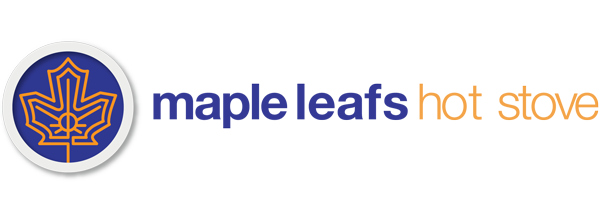
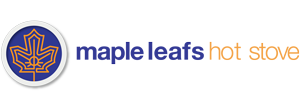
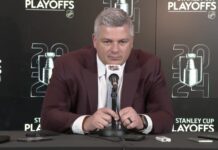

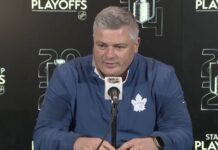
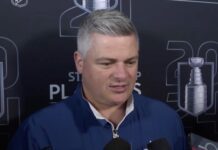

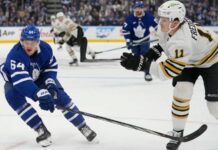

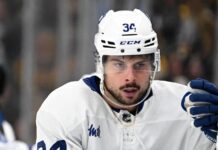
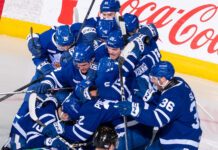
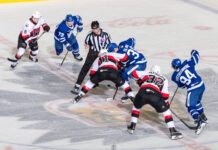
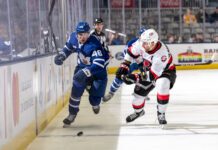

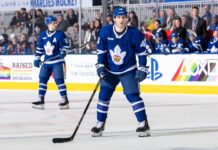


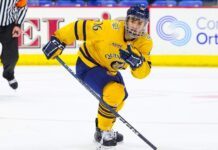
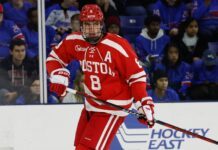
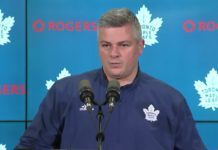


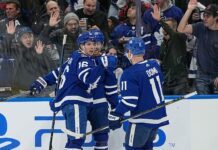
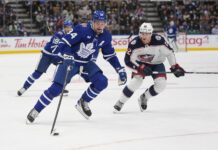
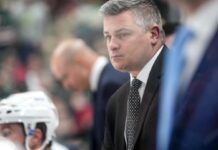
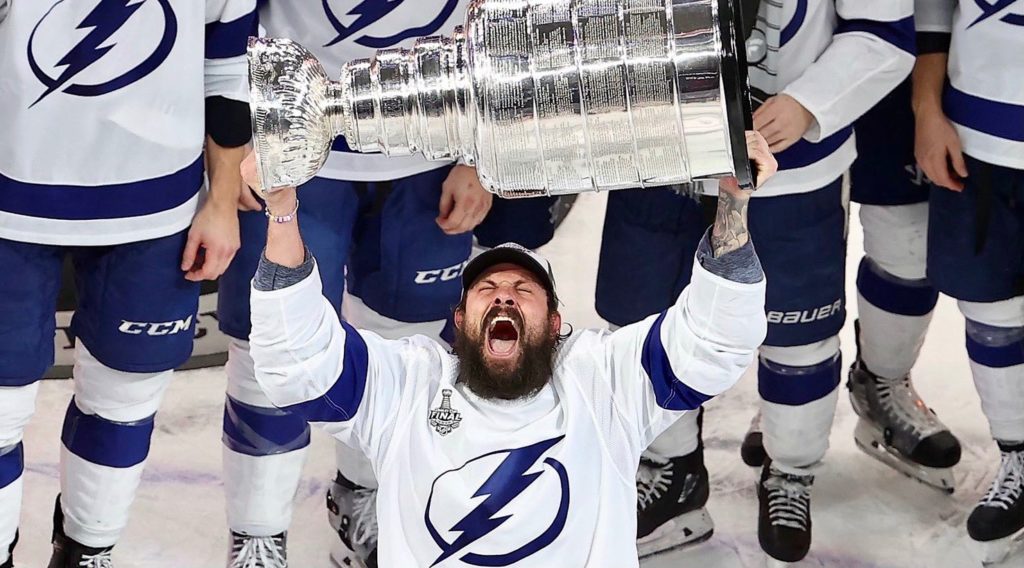
![[Leafs Links] Reports: Sean Walker likely to be moved, Maple Leafs have inquired; the latest on Chris Tanev, Noah Hanifin, Adam Henrique, Scott Laughton, Jakob Chychrun & more Sean Walker linked to the Maple Leafs](https://mapleleafshotstove.com/wp-content/uploads/2024/01/sean-walker-maple-leafs-flyers-218x150.jpg)
![[Leafs Links] The asking price for Sam Lafferty and Vladislav Gavrikov, the latest on Patrick Kane, and is Toronto lurking as a darkhorse on Timo Meier? Patrick Kane, Chicago Blackhawks trade rumours](https://mapleleafshotstove.com/wp-content/uploads/2023/02/patrick-kane-blackhawks-218x150.jpg)
![[Leafs Links] Marlies head coach names a defenseman to look out for in the Leafs’ farm system; Bruins sniffing around on Chychrun, Schenn; a timeline for Patrick Kane and Jonathan Toews’ deadline decisions Jakob Chychrun, Toronto Maple Leafs trade target](https://mapleleafshotstove.com/wp-content/uploads/2022/02/jakob-chychrun-218x150.jpeg)
